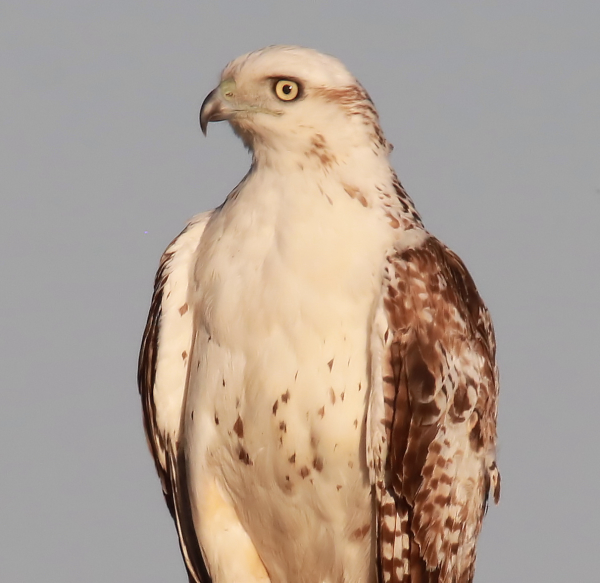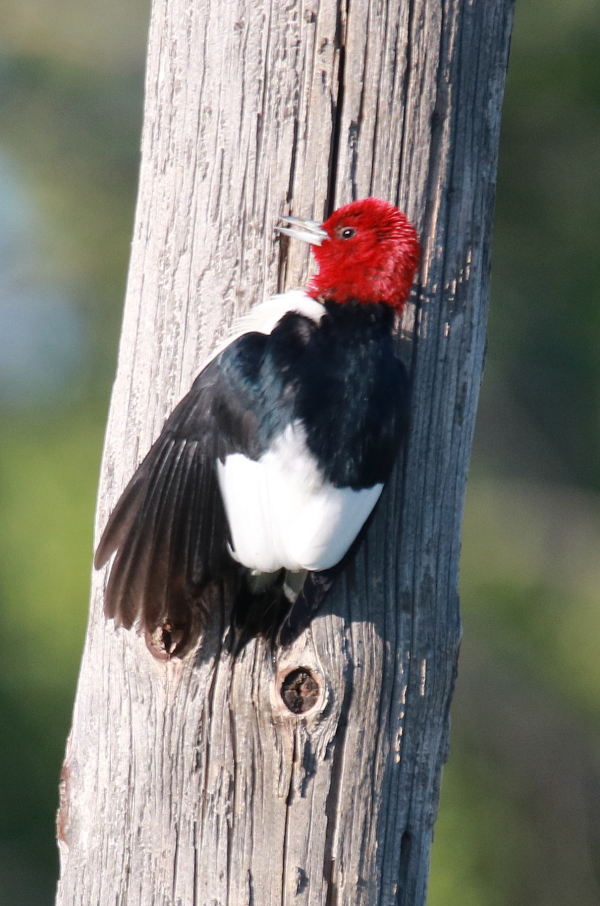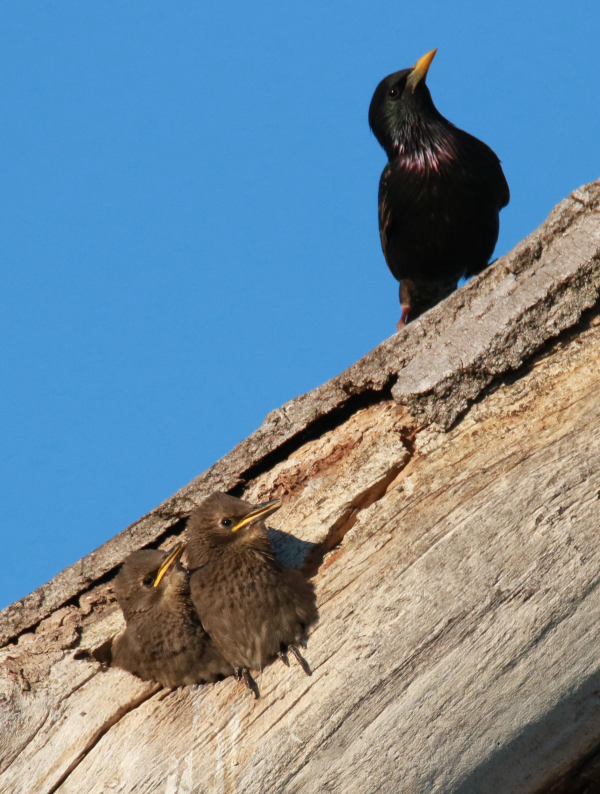
The chance to take a close portrait of a relatively rare Krider’s Red-tailed Hawk was a highlight of the week.

A Red-headed Woodpecker was photographed during an “anting” session Sunday.

An adult European Starling checks on its large nestlings at their tree cavity nest site. You can see a larger photo of the young starlings in the Backyard Birding article in this issue.
|
A few miles east of Bismarck last Wednesday, as if to mark the transition from spring migrations to summer nesting and brood rearing, I found the first duck brood of the year - a very large brood of 14 newly hatched Hooded Mergansers swimming behind a female. This was at the same wetland where I photographed the first Hoodie brood last year, although that brood consisted of a single duckling. A bit farther east it was a considerable disappointment to see that McKenzie Slough is mostly dry this season, with just a trickle of a stream winding through the center of the vast floodplain.
Last year, McKenzie was my best spring and early summer birding location when it was an expansive wetland, but such are the swings of wet and dry in this region. It also shows the difference between the Bismarck area, to the west, and the area where I live, 2 hours to the southeast. While the west side of the region is extremely dry and holds fewer birds, my neighborhood has retained good water levels after a record wet summer last year and despite drier conditions to date. Even so, summer thunderstorms have been firing up, and the region is getting inches of rain during the past 2 days with more to come. The rain may not fill any wetlands, but it will certainly green up the prairies for nesting birds, including some upland-nesting ducks and shorebirds.
White Hawk Replay
At the end of a hot Thursday, a Krider’s Red-tailed Hawk provided 2 opportunities to document it with photos, including some quality portrait-style photos during the extended second photo op. The mostly white raptor provided stunning close-up photos, but both times the hawk was perched on rather unsightly perches, including a rusty farm implement; so I cropped the bottom of the image out when I edited the photo to make it more of a graduation-style “portrait.”
I found the impressive raptor perched just a quarter-mile east of home, and when it eventually took flight I tried to get at least one good action photo, but that didn’t work out very well. However, the resulting photos did show the hawk’s tail feathers were nearly white in color, except for the 2 new ones that were growing in, which showed bright orange coloration. It made me float an idea I’ve never read or heard discussion about: It seems that Krider’s are more susceptible to sun bleaching of their tail feathers that may be orange or muted orange-white to begin with, but that fade to white or near-white over the following year. I’ve seen a few examples of this sun-bleaching effect, and perhaps that’s a factor in their tail feather coloration.
Varied Observations
Alas, a week after arriving at the Grove, the pair of Red-headed Woodpeckers that showed such promise to become summer nesting residents, evacuated the area. I did find another Red-head about 12 miles to the north-northwest in my friend Bruce’s farmyard, so I alerted Bruce to keep an eye out there and I’ll swing by periodically. Then, Sunday I expanded my woodpecker search to the south-southeast. I didn’t find any new woodpeckers, but did appreciate seeing 3 on territories that I documented a couple weeks ago.
I was able to observe and photograph one Red-head that also showed me its likely cavity site. While I photographed it, the woodpecker was acting rather weirdly, then preening its wings, followed by fluffing the feathers on its head and body and holding its wings partly open in the sun. It was apparently “anting,” permitting ants to search its feathers for parasites, perhaps feather mites (see photo).
I also found an occupied cavity formerly excavated by a woodpecker, probably a Northern Flicker, where I photographed 3 soon to fledge European Starlings. That on the end of a drive through a beautiful prairie region that held many of my favorite grassland-oriented birds, including Bobolinks, Western Meadowlarks, Upland Sandpipers, Dicksissels, Grasshopper Sparrows, Common Nighthawks, Eastern and Western Kingbirds; and where small marshes met the prairie, territorial Wilson’s Snipe. It was a great Sunday evening birding drive!
Twice during the past week I’ve seen a Red-necked Grebe on a nearby marshy bay that’s attached to a small lake. I hadn’t visited this location for a few weeks, but when I saw the June Red-necked Grebe long after it should have continued north, I recalled seeing a pair of Red-necked Grebes earlier in the year. Could they be nesting 3 miles east-southeast of home? That would be a first for this entire region so far as I’m aware of, although I’ve seen them nesting 70 miles to the east years ago. Usually, the closest nesting Red-necked Grebes are found hundreds of miles north or a like distance east, in forest and lake habitat, so I’m monitoring any activity of these interesting grebes nearby.
Feeding Station Action
It’s nice to have regular hummingbird visits this week, with one or more immature or female Ruby-throated Hummingbirds using both nectar feeders. I figured there were probably a couple first year immatures that won’t be nesting this summer alternating at the feeder, and that impression was verified Tuesday (yesterday) as I finalized this issue when 2 immatures interacted near the feeders. They are a perfect for keeping the hummingbird feeders active while adults are nesting at undisclosed locations, and for enlivening the feeding station view along with the orioles.
I’m really happy to report that a female Orchard Oriole came to the jelly feeders Thursday and thereafter, hopefully joining the regular male for a neighborhood nesting attempt. There also seems to be 2 pairs of Baltimore Orioles now, each bird showing distinctive plumage that permits me to tell individuals apart. It’s pretty exciting to have 6 regular orioles outside my bay windows, and I’m hoping for 3 successful nesting pairs that will bring their fledglings to the feeding station during July. Orioles certainly add zest to each day they appear from May through September!
After a dramatic cold spell around Memorial Day weekend, we’ve had a heat wave that’s brought a few new birds to my birdbath that features a small solar-powered fountain. The most recent thirst quenchers have been male and female American Goldfinches, and a couple more Cedar Waxwings stopped for a drink; American Robins, Gray Catbirds, and Baltimore Orioles all drink periodically. A female Baltimore Oriole had an enthusiastic bathing session Sunday; robins bathe at times too. Speaking of robins, a couple have started eating some grape jelly at the oriole feeders; not often, but a couple times a day I see them. And catbirds continue to be regular jelly feeders too along with House Finches.
Last week was something of a turning point on the calendar, and in these parts, it marked an obvious change from spring to summer. Each week forward, we can look forward to new broods, new hatchlings, and new fledglings, including new species as the weeks progress through June and into July. Enjoy the wealth of birding opportunities throughout the summer, continuing with this especial week!
Article and photos by Paul Konrad
Share your bird sightings and photographs at editorstbw2@gmail.com